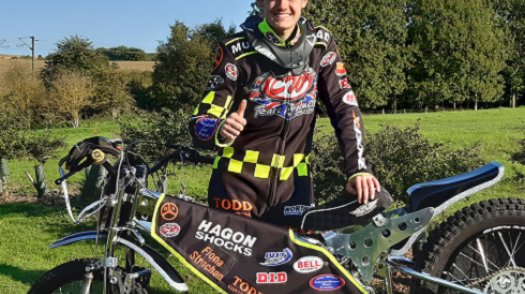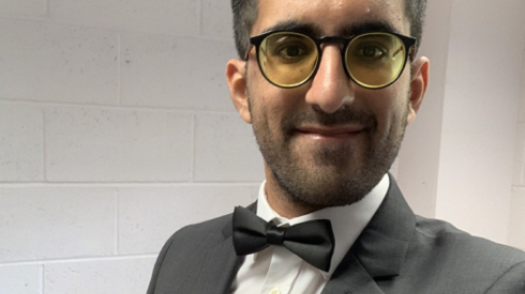
The hidden side of my brain injury
Almost three years after a speedway racing accident left him with a serious brain injury, teenager Sam shares what life is like now, and how he manages the more hidden effects of his injury.
In September 2018 Tye arrived at The Children’s Trust for intensive rehabilitation after a bleed on the brain. Now, four years later, Tye is helping Mum Amy share their story.

Published: September 2022 Date of brain injury: July 2018 (aged 11 years old)
In July 2018, Tye went to bed completely fit and well like any other day. In the middle of the night he woke up complaining of a bad headache. Not long after Tye started being sick and that’s when we felt that something was wrong.
Tye was rushed to Queens Hospital in Romford where he had an emergency CT scan that showed an intraventricular haemorrhage, a bleed on the brain. Within two hours, Tye had been transferred to Great Ormond Street Hospital where he spent four weeks in the Paediatric Intensive Care Unit.
After almost two months in hospital, we got to take Tye home for a week before travelling to The Children’s Trust in Tadworth, Surrey to continue his recovery journey.
I was so nervous on that first day, I hated it really as I just wanted to be at home but it's funny how things changed so quickly – because then I never wanted to leave.
When Tye arrived at The Children’s Trust, he was unable to stand without the assistance of two people, and he relied on his wheelchair. Tye was also struggling with his memory, and he was confused about what had happened to him and where we were.
Due to his memory difficulties, Tye needed prompts throughout the day to help get dressed, know what session he had next and where to go, as well as being reminded of who all his therapists and nurses were. To help him remember, Tye used techniques like writing down key points after each session in a notebook. That way he could then come and tell me what he had done that day.

Tye’s Physiotherapist Rachel said: “Tye progressed very quickly. I remember within his first week at The Children’s Trust he was able to stand unaided. Over the next three months, Tye worked with me twice a day to improve his balance and walking.
“A huge motivator for Tye was to return to playing football. Initially, he was unable to kick a ball without losing his balance however through lots of hard work and determination including hydrotherapy, horse riding, gym-based sessions and walking with music therapy, Tye was able to play football with his friends.”
“I remember all my sessions being very entertaining,” said Tye. “I really liked that I never knew what was going to happen next. Every day we were doing something different to achieve my goals and that helped make it fun. Whenever I was on the treadmill with Rachel, she was always pushing me forward which was nice. She was always there cheering me on and that's when I really felt like I was walking on my own again.”
Something else that inspired Tye during his sessions was regaining a level of independence. Tye had been extremely independent before his illness and was in a routine of walking to the shops near our house which he really enjoyed. Suddenly he couldn’t do that anymore and it was really tough for him.
I spoke to Tye’s physiotherapy team about it, and they wanted to help Tye, so they incorporated it into his sessions and encouraged him to walk to the local shop in Tadworth. What seemed like an ordinary every-day trip for most children Tye’s age was huge progress for Tye. It gave him back a little part of his old routine and we were both very grateful.
In addition to progress Tye was making in his scheduled sessions, some of our fondest memories are also the activities that used to happen on house in the evenings. We used to go up to Oak house (the residential house where Tye stayed) and all the children would sit around the table and just play games.
That was really nice as I think it gave the parents a little bit of breathing space as well. I didn't have to worry, because I knew that the other children were sort of in a similar situation to Tye. There was no need to explain why he wasn’t remembering certain things or his walking was a bit wobbly. There was a shared experience, a shared understanding with everyone.
And not having that is something I still struggle with now, when Tye meets new friends or other kids I think about how they won't know why he's not doing a certain thing, or why he's acting a certain way. I constantly worry about that and whether I should say something, whereas during the time we spent at The Children’s Trust I just didn't need to do that. We were all like a family.

“I was excited to go home,” explained Tye, “but I knew I would miss The Children’s Trust.”
It was scary leaving. I knew Tye was ready, but we were apprehensive about the transition to being back home again. For me, I was worried about losing the physiotherapy sessions. I didn’t know what support Tye would get, as I knew he was in a really good place with his recovery but he still needed help, and I thought it would be more difficult to access in the local community. He was given a six-week gym membership where he could use the treadmill but then he was discharged and really had to motivate himself to continue improving.
Once we got home Tye was really keen to get back to school. He started doing half days but was so determined that he went full time after about two weeks. It was hard work for Tye and he was tired when he got in from school but it was good for him to be back in a routine.
It was horrible when the pandemic meant that Tye couldn’t go into school and had to do all his work from home because having a routine is important to his ongoing recovery. “I still struggle a bit with my memory,” said Tye, “so I’ve continued using my notebook to write things down throughout the day. That’s something I started doing at The Children’s Trust.”
Having a routine helps him to know what he's doing on a daily basis, and although we appreciate things can change – the pandemic changed everything.
The most significant difference was the additional support that Tye was getting at school because of his Education, Health and Care Plan (EHCP). This wasn’t replicated at home during the lockdowns so he just had to try his best with what he could get done on the laptop each day. It’s safe to say Tye was excited to get back to in-person classes, seeing his friends and teachers daily.

Tye and I recently came back and visited everyone at The Children’s Trust. It brought back so many memories and although some of them are bad it's nice to remember them – if that makes sense. It's a weird feeling because so much happened there and it wasn’t a great time, there was a lot of stress and worry, but it was also home for three months. We can remember the progress Tye made here, and the overwhelming amount of support we received from all the staff.
“It felt amazing to be back onsite,” explained Tye. “I wanted to see how everyone was getting on and if there was anything I could do to help.” Tye is now in Year 10 and is working towards his GCSE’s. “I’ve chosen PE as one of my subjects, as when I’m older I want to be a Physiotherapist and work at The Children’s Trust. All the therapists there are just amazing, and they inspired me to want to be like them.”

Almost three years after a speedway racing accident left him with a serious brain injury, teenager Sam shares what life is like now, and how he manages the more hidden effects of his injury.

Joey was 10 when a brain haemorrhage changed his life. Mum Karen shares their story.

In 2005, Saqlain sustained a brain injury in a car accident. Last year he was awarded his PhD in Cell Biology by Brunel University London. Saqlain shares his story and tips.